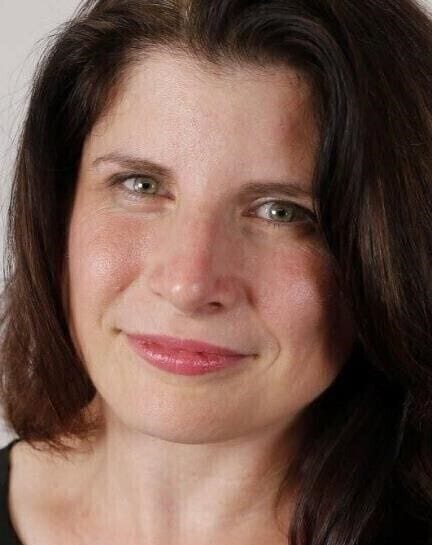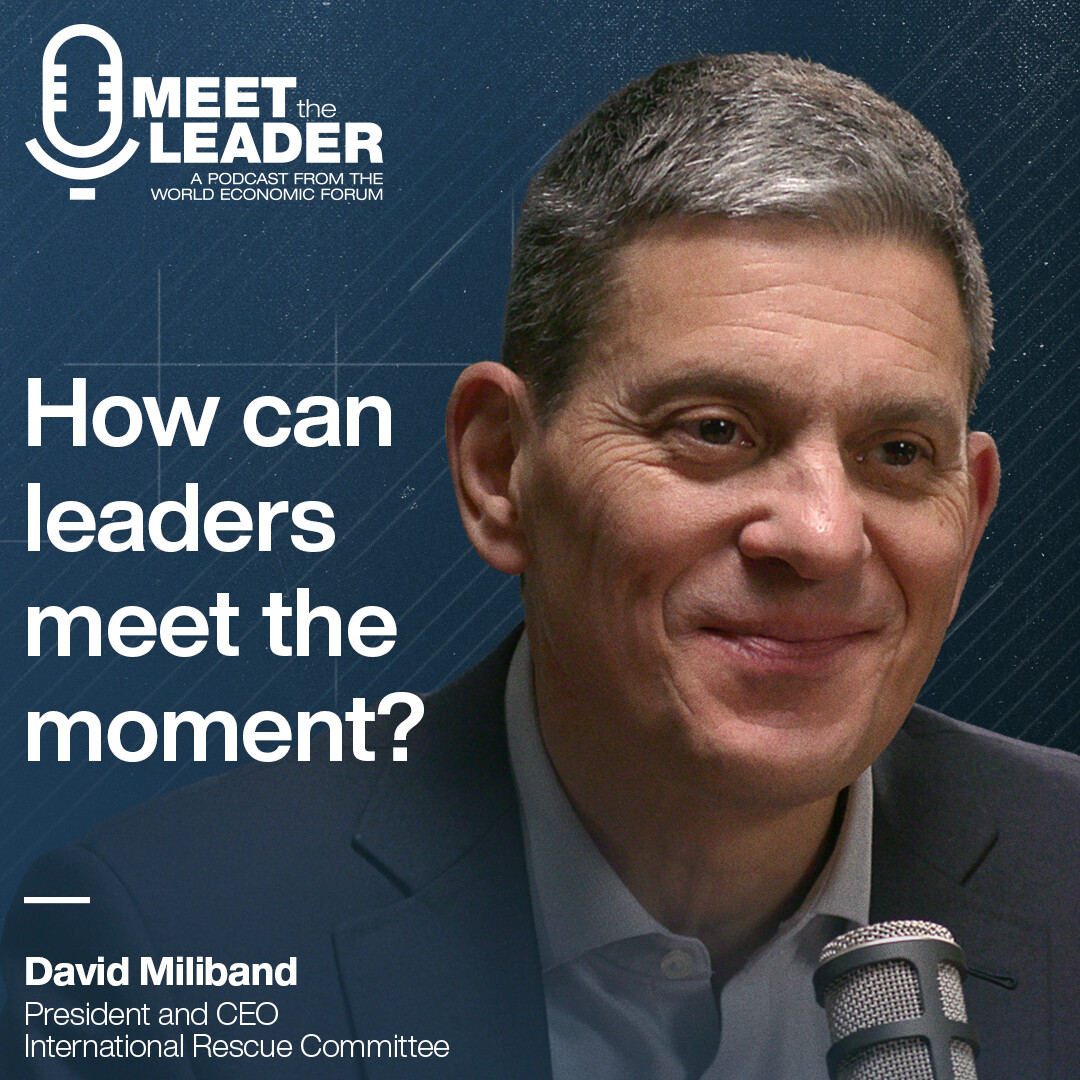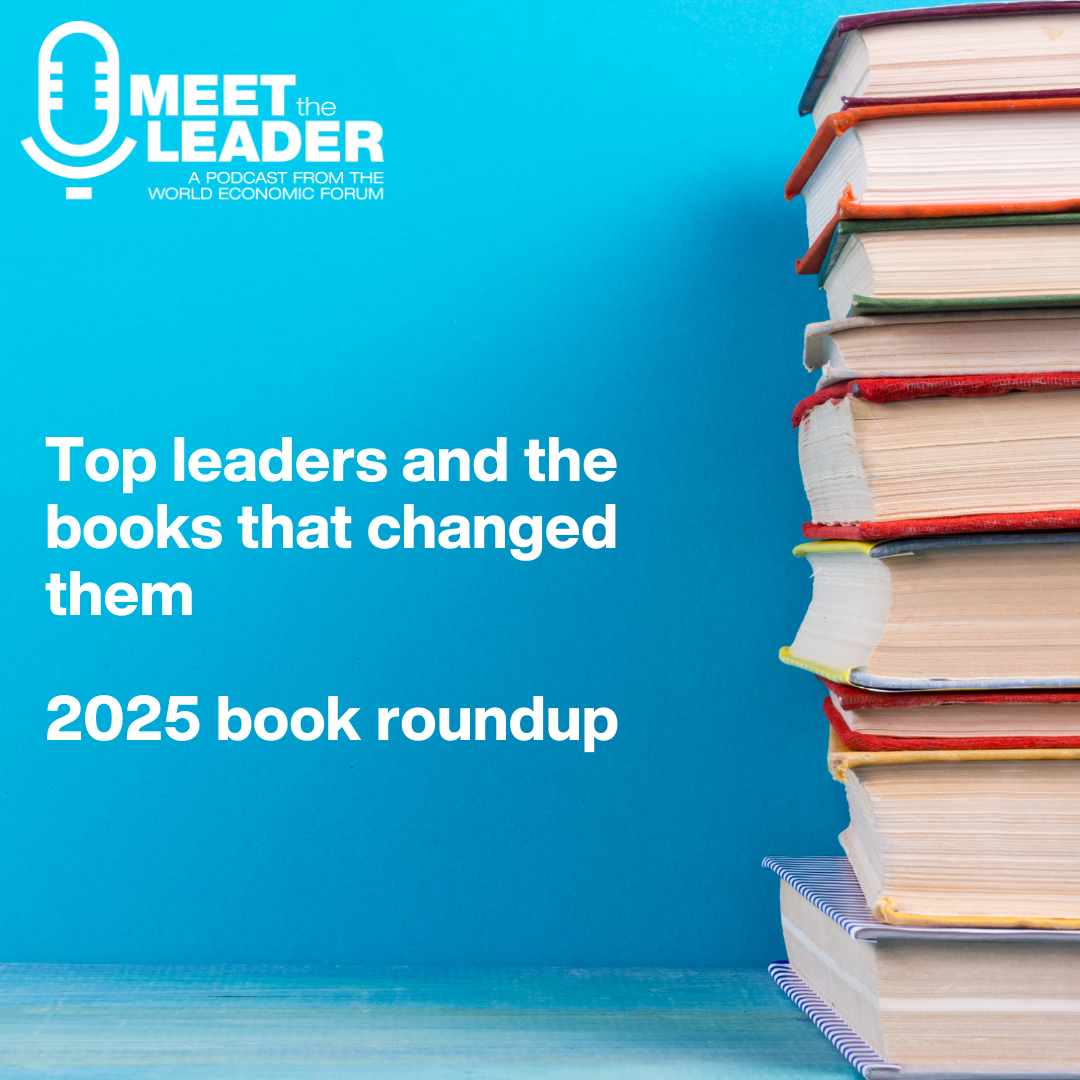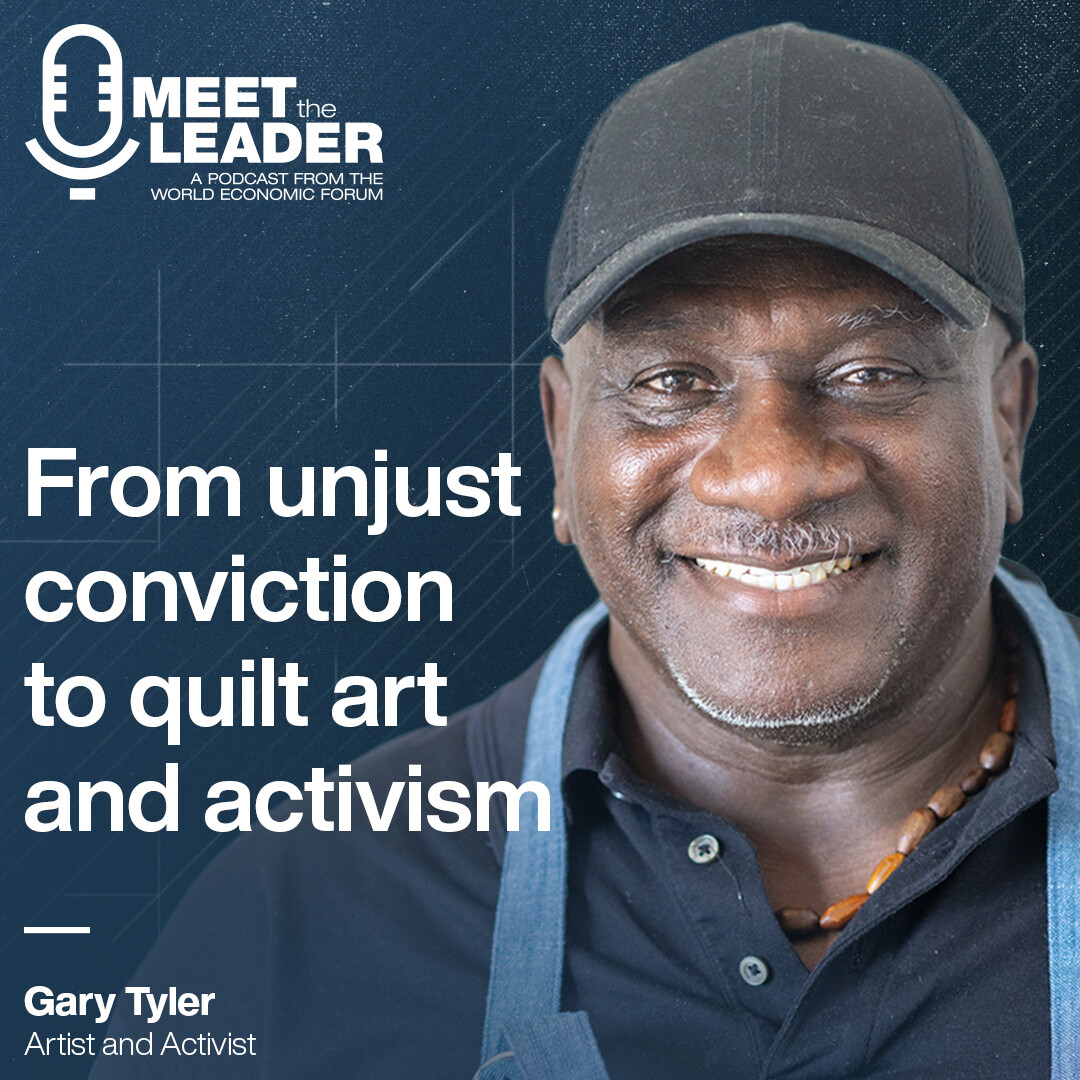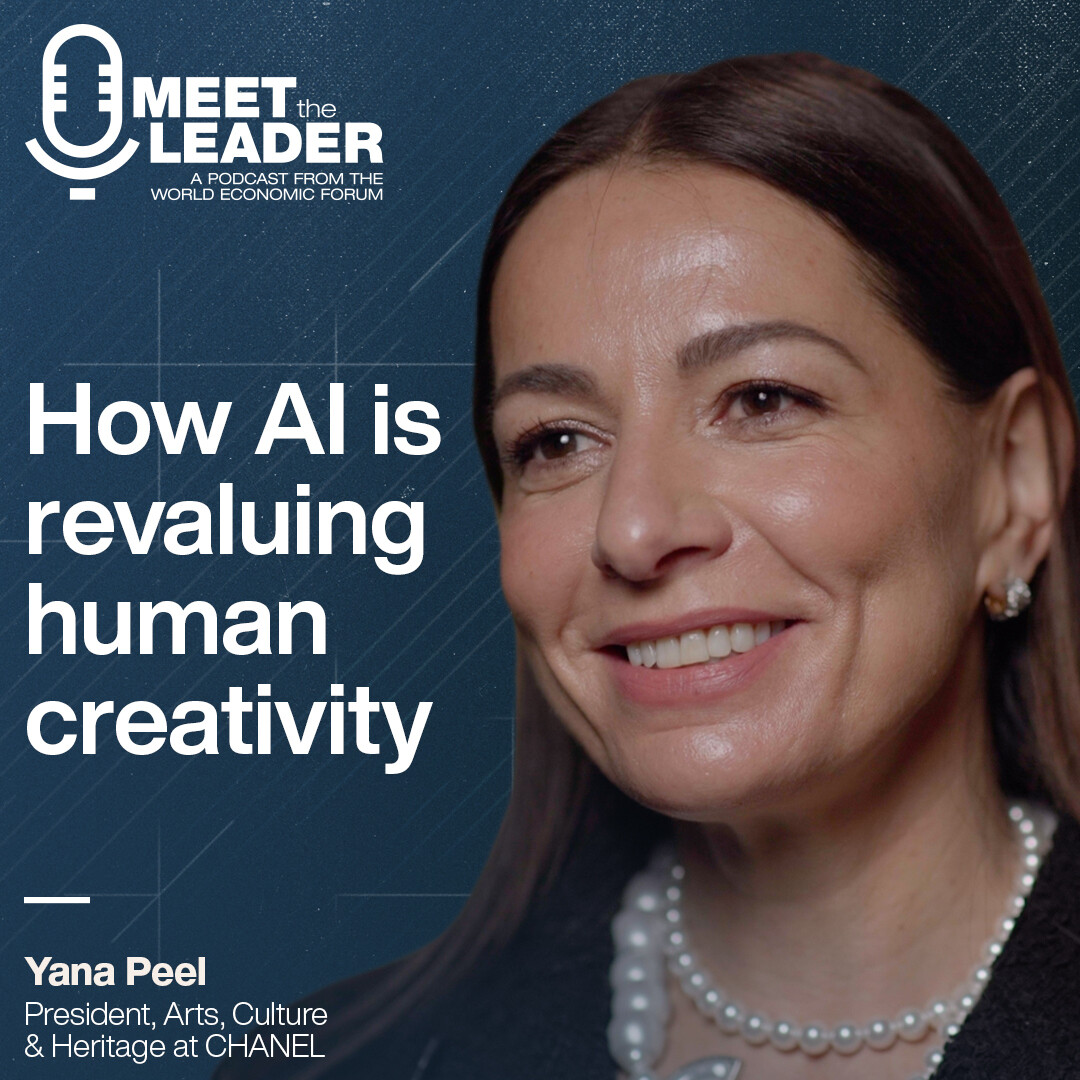There's a potential $400 trillion retirement savings gap. How leaders can fix it
ポッドキャスト・トランスクリプト
This transcript, generated from speech recognition technology, has been edited for web readers, condensed for clarity, and may differ slightly from the audio.
Linda Lacina, World Economic Forum: Welcome to meet the leader, the podcast where top leaders share how they’re tackling the word’s biggest challenges.
In today’s episode, we talk to Yie-Hsin Hung from State Street Investment Management about how retirement is changing, how we’ll bridge the $400 trillion retirement savings gap - and what leaders should focus on now.
Subscribe to Meet The Leader on Apple, Spotify and wherever you get your favorite podcasts. And don’t forget to rate and review us. I’m Linda Lacina from the World Economic Forum - and this is Meet the Leader.
Yie-Hsin Hung, State Street Investment Management: If you look at Generation X in the US – 45- to 60-year-olds – on average they save about $150,000, which we know is far less than what they need in retirement. And actually 40% of them have zero savings. And here is another disturbing statistic in that people don't always get to work to their desired retirement age. And one study indicated that only 15% or so of folks at 65 years old are actually working today. So it just says this really important to pay attention to – not when you're 40, 50 or 60, but well before then.
Linda Lacina, World Economic Forum The Retirement savings gap could grow $400 trillion by 2050, according to some estimates, a global problem that can’t just be tackled by simple saving alone.
Meanwhile, we’re living longer and longer, a reality that is changing the way we live in our later years while also making it that much trickier to save.
Yie-Hsin Hung is the CEO investment firm State Street Investment Management [Editor's note: the firm rebranded from State Street Global Advisors after recording]. I had the chance to talk with her recently about these trends and what leaders will need to do to fix it, including how leaders in governments, civil society and more will need to put together host of tools simultaneously to build new routes to financial resilience/
We talked about that - including moments that shaped her as a leader, and the simple question she asked early in her career that has helped her understand what’s needed for true, helpful, honest feedback.
We’ll get into that - but first she’ll talk about the state of financial security - and how we’re doing.
Yie-Hsin Hung: We have a very significant retirement savings gap that was estimated 10 years ago to be about $50 trillion on a global basis – although the projections are for that to grow dramatically almost eight times to $400 trillion come 2050. And the major countries that are contributing to this gap are really the largest economies in the world, starting with the US. Every single year, it starts to add $1 trillion, $2 trillion to that gap; they represent about 33% of that $400 trillion, if you will. China follows at 30%, India at 20%.
The three-legged stool that people have come to rely on – government pensions, employers' and their own personal savings – has become somewhat wobbly.
”Now that's at a global level. At an individual level, I think there's a lot of anxiety. Because the three-legged stool that individuals have come to rely on – governments providing a safety net, employers providing a pension plan and their own personal savings – has become somewhat wobbly, and individuals are feeling like the onus is much more on them today. And then you take recent events like the pandemic that obviously created a need for tapping into emergency savings. That hasn't been as easy to do with retirement savings plans – although Secure 2.0 in the US has actually made that better. Individuals are concerned about the level of debt that they see at their government level. So there are worries about whether those retirement plans that they've come to rely on will actually be there. And then with recent inflation, people are also worrying about whether they can save enough for their ultimate retirement. So I'd say there are real issues both at a macro as well as micro level.
Linda Lacina: And what very broadly speaking is needed to help tackle this?
Yie-Hsin Hung: It really requires those three parts of the stool I talked about: government, employers and individuals.
At the government level, what's really necessary is a universal pension safety net and a mechanism for encouraging and facilitating individuals to be a part of a well-managed retirement plan. So that could be fiscal plans or tax savings requirements like auto enrollment, which means you are automatically enrolled in a plan once you join. Or auto-escalation, meaning that the amount that you contribute over time automatically increases.
All of this makes a difference. Take auto-escalation: If you look at somebody who has that as part of their plan and one who doesn't, in year one there's very little difference in terms of their savings rate. But by year three, there's a two and a half percentage points difference, and that's meaningful over a person's lifetime.
The second part is employers. So obviously, if there are government mandates to provide provisions like auto-escalation and auto-enrollment, what can they do to support to a greater degree those that are making less. To help them really save for retirement, as well as provide the financial advice and guidance that so many individuals need that are very confused about: what is the right savings rate, what kind of return should I expect, how do I think about living longer?
And then lastly, for individuals to really build a plan and ideally do that with professional financial advice. So they can play out those different scenarios and really understand what's reasonable to assume that they need when they want to retire. And what that means over the course of their lifetime.
Linda Lacina: Is there anything going right that be be used as a model when it comes to tackling these issues – something that might surprise people and give a little sense of hope?
Yie-Hsin Hung: To go back a little way, in 2012 the UK sought to increase the number of private sector employees covered by plans. Their National Employment Savings Trust (NEST) embarked upon this programme to facilitate private sector companies to cover individuals. And so they started with a 2% contribution, which grew to 8% contribution over a period of six years. Within a decade, they increased the number of private sector employees being covered from 47% to close to 80%. And I think the number is close to 90% today. So it doesn't take that long a period of time, but with real intention on the part of the government.
Improving financial security doesn't take that long a period of time with real intention on the part of the government.
”Linda Lacina: For individual people, with the current statistics on housing affordability and inflation, saving for retirement is maybe not something that they can focus on. What can they do? Is there a mindset to adopt that can be practical and can help?
Yie-Hsin Hung: On balance, what we've seen is that individuals have been increasing the amounts that they save towards retirement. We say: one day a week. Take one day's worth of your compensation a week and set that aside. Obviously, the earlier that you do this in life, the longer you have to earn enough for your ultimate retirement.
And to keep in mind that you can't just put it in cash. You have to really think thoughtfully about investing that in a way where your money works for you. This is where really leveraging advice is important – to the extent that you work for a company that has a retirement plan to max out on your contributions, if you can gradually increase over the course of time.
And I think it's also important on the back side, too. That's where that education comes into play, because people oftentimes may get to retirement, having accumulated this large sum. But then there's the possibility you may live longer than you expect, so should you be looking at programmes that provide guaranteed income or in-plan annuities? So that you spend down some of your savings, but then you also know that you have income for the rest of your life.
Linda Lacina: Should people be thinking differently about how they plan for retirement? Given some of these issues that you've talked about: That we are living longer, and people might not be factoring in the fact that they could live to be 90. And the way that they live might also be different: They might be looking to work a little bit, but maybe also have time to enjoy their family and friends. How has the nature of retirement changed and how will that necessitate a change in how people plan?
Yie-Hsin Hung: With retirement, people have often thought there's a certain age you get to: 65. There was a period of time where maybe that was life expectancy. Today of course, people are living much longer. Average lifespans are in the mid-80s. And that may be the average, but there are people that will live longer. So it's a case of figuring out how much you need to set aside if you should be so fortunate to live that long and to be able to have the kind of lifestyle you need. Thinking about the rate of return, even if all you did was take all your retirement savings and put it into really safe certificate of deposits or money market funds. And what that yield generates, how does that compare to what you need to really live the life that you have today? That's probably the easiest way to do that comparison.
Linda Lacina: What is State Street doing to tackle this problem?
Yie-Hsin Hung: We're very much focused on delivering turnkey retirement solutions. We're one of the largest providers of target date funds in the US and for a variety of different pension plans and other retirement schemes around the world. A big part of that is education, providing that glide path so that people don't have to make that asset allocation decision.
All they have to do is make that decision to invest in the retirement plan and then indicate, you know, a couple of measures. First and foremost, when do they expect to retire? And we'll take care of the rest in terms of that glide path, how much in equities, how much in fixed income? Managing that over the course of time, so no one has to worry about rebalancing. And importantly, we've come up with a new product that's called IncomeWise that really builds this deferred annuity into the plan.
We've partnered with firms where they provide a simple interface for individuals like you and me. We can say: OK, what percentage of my savings do I want to use to purchase this deferred annuity? Because I can play with how much I need to spend, what kind of lifestyle do I want? It is a combination of creating products that really address not only the accumulation phase, but also the decumulation phase, and then coupling that with education.
Linda Lacina: As State Street has created these programmes, what's been something that you feel like might be surprising or overlooked by people in terms of that education phase?
Yie-Hsin Hung: These statistics are a little alarming, but if you look at Generation X in the US – 45- to 60-year-olds – on average they save about $150,000, which we know is far less than what they need in retirement. And actually 40% of them have zero savings. And here is another disturbing statistic. And that, you know, for a variety of reasons, people don't always get to work to their desired retirement age. It could be a late stage, lay-off or having to step out of the workforce to take care of ageing parents or even having a personal health issue themselves. And one study indicated that only 15% or so of folks at 65 years old are actually working today. So this is something to which it's really important to pay attention – not when you're 40, 50 or 60, but well before then.
If you look at Generation X in the US on average they save about $150,000, which we know is far less than what they need in retirement. And actually 40% of them have zero savings.
”Linda Lacina: Suppose we are able to give people the education they need and give them the right guidance on what the world will look like in 10 or 15 years. How does retirement change?
Yie-Hsin Hung: Obviously, it's a much more secure future. And that's what we want for all of us. I mentioned earlier that people are living longer, which is a great thing. But at the same time, we know birthrates are declining around the developed world. And so these pay as you go plans – social security is a really good case in point – may not be there for young people. You also have this tremendous growth of the gig economy: people that aren't working for typical employers or working on a part-time basis. It's estimated to be something like 2 billion workers around the world who don't even have access to a retirement plan. What we've seen in our research is that if someone does have access to a retirement plan, they're 15 times as likely to save for retirement. Just having that education, that framework is really important. And for those that are really planning well ahead, I think it's actually a great thing to look forward to that retirement, to be able to enjoy family, friends and the things we all enjoy.
Linda Lacina: Your background is in mechanical engineering. What drew you to that?
Yie-Hsin Hung: I followed in my father's footsteps. In my family, there were only a couple of choices for college majors: It was either engineering, medicine, or reconsider your decision. So I chose engineering. But I've always been a problem-solver. And so it was a great way to express that.
But when I came out of engineering, I had a chance to work in an internship. And I found myself thinking about: What is the company strategy? What are their products? How do they make money? So I had the fortune to go on to business school right from there, and I got introduced to finance. And that's really where all of my career has been.
Linda Lacina: How do you think you approach problem-solving differently from someone without a mechanical engineering background?
Yie-Hsin Hung: In many respects, it's really just a point of view. I feel like there isn't a problem out there that can't be solved. Because my career has involved a variety of different moves, whether by function or different companies, over the course of time I found myself oftentimes outside my comfort zone, or not the smartest person in the room. And so I've learned to lean on the strength and the perspective and the expertise of others. Where you put a problem in the middle of the room or a big goal and together fashion the right direction to go in. It's that belief that, with intent, with the right people around the table, with a big goal in mind, you can find the right solutions.
Linda Lacina: Our Future of Jobs Report that just came out, has some really interesting statistics about the soft skills that need to be shored up, including in leadership. Some of that has to do with being collaborative, being a good communicator, but also those analytical and problem-solving pieces. In your mind, what can leaders do to shore up their problem-solving skills? If they can get 5% better, what should they think about?
Yie-Hsin Hung: It's both: the combination of those problem-solving skills, as well as that emotional quotient. Because following the pandemic, the balance of power shifted between employers and employees. Not only in terms of winning minds about which future direction to take. There are big problems to solve, but for every problem there's an opportunity – so how do we go after that? But also recognizing that we need hearts and minds, too. And if there is a purpose, real meaning in what we're trying to accomplish together, you then have a tremendously energized group of people that feels like regardless of whatever that problem might be, there is a solution; an intent and a desire to really achieve that.
Linda Lacina: What do you do to engage people in their purpose?
Yie-Hsin Hung: It's really having just one-on-one conversations, obviously talking about what are we trying to do as a company, but also trying to understand what matters to them. Where do they see themselves in five years? What are the really critical things that make them get up every day? If leaders can tap into that sense of meaning or purpose, I think that makes all the difference in the world.
Linda Lacina: In your career, was there any sort of challenge or role that you was shaping for you and even changed how you lead?
Yie-Hsin Hung: Early on in my career, I had a very big project that I was presenting to a senior group of people, a committee. I went in there and there were so many arguments against what I was that I was proposing. I almost lost the project. And I remember coming out of that meeting talking to my co-head and said, I don't know what I did. What should I have done differently?
And it was that moment that he ended up just giving me really honest, candid feedback about talking to people in advance, understanding what the issues are, so that you come into a meeting like that much better prepared. But the bigger message for me was the value of feedback. We were talking about solving problems; it's hard to solve a problem if you don't know what it is that you're trying to solve for.
That's important for each of us in our career journeys: knowing what are those things that we really can work on to improve. And that's been the gift that just kept on giving for me.
Linda Lacina: You did an interesting thing where you asked your colleague: What should I have done? You asked for advice. How important is that to make people feel safe when giving or receiving feedback?
Yie-Hsin Hung: It's so important. Sometimes it's really difficult to get feedback, right? So it can be helped by me asking: can I give you some feedback? Or also yourself opening the door and saying: I just I don't think I did a very good job there. What did you think? I feel like I could have done this, this and that better. And to just listen, because sometimes it's very tempting to be a little defensive and to argue as to why that person's wrong. But that's the fastest way to shut down that feedback.
Linda Lacina: Absolutely. The other interesting thing is this idea of building trust with someone. How important is it to put that feedback into action so they know that it's not just performative? That you really are going to walk the walk once they give you the advice.
Yie-Hsin Hung: That's critical in all that we do. For me, fundamentally, trust is you do what you say, right? If you're going to ask for input, but you don't actually do anything with it, that's not actually being true to that. Not that you can solve everything, but even acknowledging what that feedback is, the steps that you've taken, seeking more feedback along the way, I think all goes a long way for others to feel really invested in you. And ultimately, that's such a beneficial approach for your long-term career.
For me, fundamentally, trust is you do what you say. If you're going to ask for input, but you don't actually do anything with it, that's not actually being true to that.
”Linda Lacina: Are there any habits that you depend on in your work, which you wouldn't be able to work without?
Yie-Hsin Hung: I pay a lot of attention to what we accomplish. I'm very aspirational, not only with myself, but our business or what we're trying to accomplish. Because my view is: Why not aim high? If you fall a little short, it's better than aiming too low and achieving it. So that's one piece. The other piece is how we go about accomplishing that. And that means including people in the process, really hearing people out, making sure we're thinking about all realms of the problem that we're trying to solve before we move too fast. So it's the combination of what we want to accomplish, but also how we get there.
Linda Lacina: How does that help you work? Has it changed results for you?
Yie-Hsin Hung: It's enabled us to move so much faster. It very much plays to what I talked about before: having a career that put me outside my comfort zone and creating that safe environment where all ideas are welcome. And then as a team figuring out which ones will make the greatest impact. And together, really fashioning a path forward. The benefit of that is you've got lots of different opinions, but you also have tremendous investment in the direction in which you're headed.
Linda Lacina: You talked earlier about that example where you were able to ask for feedback. I wonder: Are there other ways that people can look for feedback? What I'm getting at is in our world where we have hybrid situations, where in the olden days everybody was in the office, everyone could see how different departments and personalities worked together. And you could apprentice because you could understand: Here's my piece and here's how it fits into the whole.
Remote work is wonderful and has all kinds of benefits – but it is harder maybe to understand how personalities work, as well as different communication techniques and leadership techniques that you can borrow and steal from very smart colleagues. What would you suggest for workers to seek different ways that they can learn, even passively, from their their colleagues? What else should they be thinking about doing in order to give themselves feedback, however they can?
Yie-Hsin Hung: In many ways it's similar to being live one-on-one. It's about taking the time to really build those relationships. I think what has happened in the virtual world, we got incredibly efficient. In the very beginning, we spent time asking people how they're doing, what's going on. You saw what was happening in the background. And that gave way over time to just being focused on whatever the task it is at hand.
We got overly efficient in the virtual world. But we must remember to set aside time for the people element.
”And so we must remember that people element: setting aside time, reaching out broadly. Because that's another thing that has happened is the circle that we engage in in the virtual world gets smaller. And we have to be purposeful about expanding that; there's value in bringing people together. Collaboration, creativity, brainstorming are important for us to do. Even if most employees are hybrid or virtual.
Having that opportunity for everybody on the team to feel like they're part of a broader community and a network and a part of something that's bigger than themselves is a very important investment. It's a way of really investing in our people, too.
Linda Lacina: You talk about about how efficient we've gotten, and of course a lot of our research talks about how economies are going to be very focused on tasks and skills. That itself can lose that relationship element that can bring very important work. If I were a leader listening or watching this, how important is it for me to balance both? How do we get excellent at tasks, whether it's AI or myself doing them? And how do we also get really good at relationships? Do we need to balance both at the same time?
Yie-Hsin Hung: I think so. When you look at career advancement studies, particularly when you think about women or people in minority groups, they don't necessarily have that built-in network. It's so important for all of us early on in our careers not just to be heads-down, focus on the task. Because having that sense of curiosity, understanding the bigger picture come through lots of conversations, spending time learning about things that may be outside of your specific domain. But oftentimes that's when the a-ha moment comes or another idea gets sparked. It's about being conscious, because all we have as individuals is our time – so where are we devoting that time? Having a good balance is really important.
Linda Lacina: Is there a book you recommend?
Yie-Hsin Hung: The one business-orientated book that I always go back to is Good to Great. It really just talks about the criticality of people and this whole idea of: it takes a lot to begin to create a movement. If you can create that sense of purpose, that one driving factor, having the right people in the right seats, that's what really changes the dynamic.
Linda Lacina: How has it helped you?
Yie-Hsin Hung: It's really helped me to reframe every time that I find myself in a new situation or a new role. To take a step back and think about the critical things I really have to get right as a leader. And oftentimes it does fall into: strategy, culture, talent. That book speaks a lot to each of those components.
Linda Lacina: Your last question is what should leaders be prioritizing in 2025?
Yie-Hsin Hung: I think 2025 is an interesting year. If 2024 was a year of elections, 2025 is a year of policy changes. And so it's very difficult as we sit here today to exactly project what 2025 is going to look like. Frankly, it's probably difficult in any given year. But we must think hard about the different scenarios and diversifying your portfolio; the alternate paths and the steps that you might take today to be in a better position, depending on what might happen.
Linda Lacina: That was Yie-Hsin Hung. Thanks so much to her. And thanks so much to you, for listening.
The World Economic Forum’s Longevity Economy Initiative looks at the changing nature of living longer and how we can make the most of its social and economic potential. To learn more about that and our special Longevity Economy Principles, we’ll have a link in our show notes. And to listen to more podcasts, including my colleague’s podcast Radio Davos, go to wef.ch/podcasts.
Find a transcript of this episode - as well as transcripts from my colleagues’s podcasts Radio Davos an the Book Club podcast at wef.ch/Podcasts..
This episode of meet the leader was produced and presented by me with Jere Johannseon and Taz Kelleher as editor, Juan Toran as studio engineer in Davos and Gareth Nolan driving studio production.
That's it for now. I'm Linda Lacina from the World Economic Forum.. Have a great day.
The retirement savings gap could grow to $400 trillion by 2050 a global problem that can’t just be tackled by simple saving alone. Meanwhile, we’re living longer and longer, a reality that is changing the way we live in our later years while making it trickier to save for. Yie-Hsin Hung, the CEO of State Street Investment Management, will break down this problem and the new multi-prong approaches from all parts of society that will be needed to fix it. She also shares the moments that shaped her as a leader (like the simple question she asked early in her career that has helped her get honest feedback to this day).
This interview was recorded at the Annual Meeting in Davos, Switzerland in January 2025.
トピック:
金融と通貨システムその他のエピソード:
「フォーラム・ストーリー」ニュースレター ウィークリー
世界の課題を読み解くインサイトと分析を、毎週配信。
もっと知る 金融と通貨システムすべて見る
Shuyin Tang and Subhashini (Shuba) Chandran
2025年10月23日

